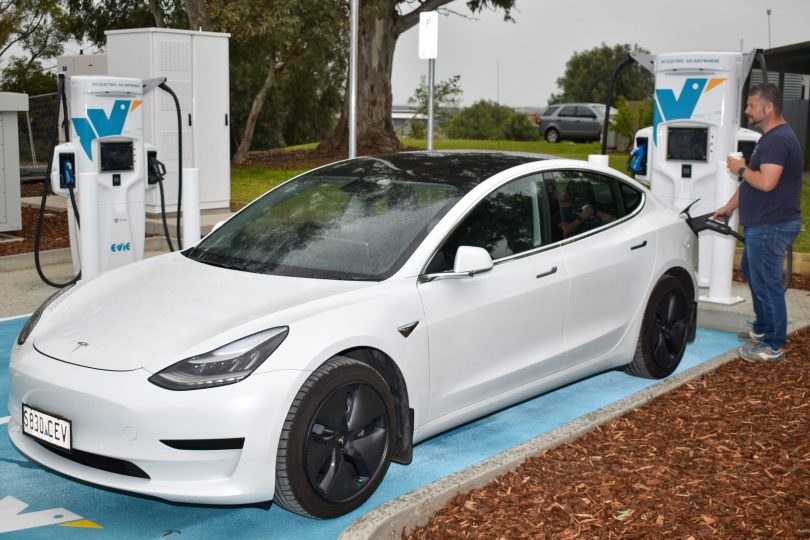
ActewAGL CEO John Knox and Evie Networks CEO Chris Mills with the Tritium fast charger and Nissan Leaf. Photo: Ian Bushnell.
Charging an electric vehicle will soon become much easier in the ACT, with energy company ActewAGL partnering with the Evie national charging network to roll out 20 fast chargers across the Territory, and possibly across the border to Queanbeyan and Yass.
The phase one rollout of Australian-made Tritium 50 kW fast chargers from Tuggeranong in the south to Gungahlin in the north will take place over the next 12 to 20 months and cater to forecast demand for EV take-up to 2027. After that, the installation of more chargers will depend on demand.
A lack of charging infrastructure is a key impediment to EV take-up. The Canberra rollout will be supported by Evie, which is also installing 350 kW Ultrafast chargers at Marulan on the Hume Highway.
Evie owned and operated ultra-fast chargers cost 60 cents per kilowatt-hour and 40 cents per kilowatt-hour for fast chargers. Both cater to European and Japanese plug types, which make up a majority of the electric vehicles within Australia.
But not all have the capacity to take that much charge, although the next-generation vehicles will.
ActewAGL has been running about a dozen pilot charge points in Canberra since 2016 and plans to upgrade most of them and transfer customers to the app-based Evie network.
All up that could mean up to 25 charge points across the Canberra region, with ActewAGL also talking with the Queanbeyan-Palerang and Yass councils.
CEO John Knox said the deal would offer customers a choice about decarbonising transport. Evie uses 100 per cent renewables electricity, but “it’s also good for the wallet as well”.
He said charging an EV was about a third less than the cost of a petrol or diesel vehicle. For example, a Nissan Leaf with a 350 km range will cost about $20 a week to fuel, given most charging will be done at home or work.
The charging stations will be available 24/7 and follow the Evie model of combining them with amenities such as retail to ensure they are safe and secure places to use.
Charging times depend on the size of batteries, but the 50 kW fast chargers take between 20 minutes and an hour to charge, although it is expected that most people will only charge up to get home.
The 350 kW highway chargers can provide an 80 per cent charge in 10 minutes.
Mr Knox said the network would remove range anxiety and give drivers more confidence.
“What we are doing in Canberra and the capital region will enable customers to travel across the border and have that peace of mind knowing they’ve got EV infrastructure up and down the east coast,” he said.

An Evie ultrafast charging station at Taliem Bend in South Australia. Photo: Evie Facebook.
Evie Networks CEO Chris Mills said the timing was perfect for extending coverage to Canberra, with the take-up of EVs accelerating overseas as governments develop policies to promote and support the new technology.
He said that while there was a lack of policy at the federal level, the states and territories were more progressive, and the company was working with them to boost the infrastructure required to increase uptake.
The other big factor is the price of vehicles, but he said that a sub-$35,000 EV would be available at the end of the year, and the cost would continue to fall.
“You’ll see the price of cars come down, and I think they’ll come down faster than we’ve been expecting,” he said.
Mr Mills said the company was limited to the east coast at present, but its vision is to go national.
He said that it would increase the number of chargers at highway stations as demand rose.
But for town driving, charging stations were more convenient for those who did not have off-street parking where they could charge at home.
Calling it a refuelling paradigm change, Mr Mills said that while previously motorists had to go to a petrol station to fill up, with EVs, 80 per cent of charging would be done at home or work.
“When you look at the cost of charging at home plus the cost of charging on the charging infrastructure, you look at the weighted average of that, you’re getting a 40 per cent improvement on the cost of fuel,” he said.
Australian Electric Vehicle Association ACT branch chair Rob Ogilvie said the deal was great news for Canberra’s 1038 EV owners, saying a lack of charging infrastructure was one of the things holding back their uptake.
“The ActewAGL trial was a toe in the water. Now it’s a big push,” he said.
“This infrastructure, with the ACT Government incentives as well, allow for apartment dwellers [to take] short trips down to the coast as people won’t have to feel that they need to own a 400 km-range vehicle.”
He said while the ACT Government was leading the charge, there was a vacuum at the federal level, and a lot of rules were inhibiting the importing of EVs, particularly second-hand vehicles.
“But people are saying that despite what the government decisions are, we’re doing it anyway,” he said.
Evie already partners with every petrol retail company, and other third parties and energy providers.
ActewAGL already offers 4000 km free charging and plans further products as part of this deal. It also plans to offer home charging installation.
“This concept of having a home energy ecosystem … as we move forward, it’s going to be about designing what works for each individual consumer,” Mr Knox said.





















